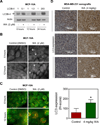Autophagy fails to alter withaferin A-mediated lethality in human breast cancer cells
- PMID: 23607597
- PMCID: PMC3723758
- DOI: 10.2174/15680096113139990039
Autophagy fails to alter withaferin A-mediated lethality in human breast cancer cells
Abstract
We have shown previously that withaferin A (WA), which is a highly promising anticancer constituent of Ayurvedic medicine plant Withania somnifera, inhibits viability of cultured breast cancer cells in association with reactive oxygen species (ROS)-dependent apoptosis induction. Because ROS production is implicated in induction of autophagy, which is an evolutionary conserved process for bulk degradation of cellular components including organelles (e.g., mitochondria) and considered a valid cancer chemotherapeutic target, we questioned whether WA treatment resulted in autophagy induction. Indeed exposure of MDA-MB-231 and MCF-7 human breast cancer cells as well as a spontaneously immortalized and non-tumorigenic normal human mammary epithelial cell line (MCF-10A) to pharmacologic concentration of WA resulted in autophagy as evidenced by transmission electron microscopy, processing of microtubuleassociated protein 1 light chain 3 isoform B, and/or acridine orange staining. Inhibition of MDA-MB-231 xenograft growth in vivo by WA administration was also associated with a significant increase in level of LC3 protein in the tumor. However, WA-mediated inhibition of MDA-MB-231 and MCF-7 cell viability was not compromised either by pharmacological suppression of autophagy using 3-methyl adenine or genetic repression of autophagy by RNA interference of Atg5, a critical component of the autophagic machinery. Finally, Beclin1 was dispensable for WA-mediated autophagy as well as inhibition of MDA-MB-231 cell viability. Based on these observations we conclude that autophagy induction fails to have any meaningful impact on WA-mediated lethality in breast cancer cells, which may be a therapeutic advantage because autophagy serves to protect against apoptosis by several anticancer agents.
Conflict of interest statement
No competing financial interests exist.
Figures






Similar articles
-
Molecular targets and mechanisms of cancer prevention and treatment by withaferin a, a naturally occurring steroidal lactone.AAPS J. 2014 Jan;16(1):1-10. doi: 10.1208/s12248-013-9531-1. Epub 2013 Sep 18. AAPS J. 2014. PMID: 24046237 Free PMC article. Review.
-
Withaferin A causes FOXO3a- and Bim-dependent apoptosis and inhibits growth of human breast cancer cells in vivo.Cancer Res. 2008 Sep 15;68(18):7661-9. doi: 10.1158/0008-5472.CAN-08-1510. Cancer Res. 2008. PMID: 18794155 Free PMC article.
-
Withaferin A inhibits experimental epithelial-mesenchymal transition in MCF-10A cells and suppresses vimentin protein level in vivo in breast tumors.Mol Carcinog. 2015 Jun;54(6):417-29. doi: 10.1002/mc.22110. Epub 2013 Nov 30. Mol Carcinog. 2015. PMID: 24293234 Free PMC article.
-
Withaferin A-induced apoptosis in human breast cancer cells is mediated by reactive oxygen species.PLoS One. 2011;6(8):e23354. doi: 10.1371/journal.pone.0023354. Epub 2011 Aug 10. PLoS One. 2011. PMID: 21853114 Free PMC article.
-
A Comprehensive Review and Perspective on Anticancer Mechanisms of Withaferin A in Breast Cancer.Cancer Prev Res (Phila). 2020 Sep;13(9):721-734. doi: 10.1158/1940-6207.CAPR-20-0259. Epub 2020 Jul 29. Cancer Prev Res (Phila). 2020. PMID: 32727824 Free PMC article. Review.
Cited by
-
Synergistic antitumor effect of 5-fluorouracil and withaferin-A induces endoplasmic reticulum stress-mediated autophagy and apoptosis in colorectal cancer cells.Am J Cancer Res. 2020 Mar 1;10(3):799-815. eCollection 2020. Am J Cancer Res. 2020. PMID: 32266092 Free PMC article.
-
Role of mitogen-activated protein kinases and Mcl-1 in apoptosis induction by withaferin A in human breast cancer cells.Mol Carcinog. 2014 Nov;53(11):907-16. doi: 10.1002/mc.22050. Epub 2013 Sep 9. Mol Carcinog. 2014. PMID: 24019090 Free PMC article.
-
RNA-seq reveals novel mechanistic targets of withaferin A in prostate cancer cells.Carcinogenesis. 2020 Jul 10;41(6):778-789. doi: 10.1093/carcin/bgaa009. Carcinogenesis. 2020. PMID: 32002539 Free PMC article.
-
Withaferin A Induces ROS-Mediated Paraptosis in Human Breast Cancer Cell-Lines MCF-7 and MDA-MB-231.PLoS One. 2016 Dec 29;11(12):e0168488. doi: 10.1371/journal.pone.0168488. eCollection 2016. PLoS One. 2016. PMID: 28033383 Free PMC article.
-
Molecular targets and mechanisms of cancer prevention and treatment by withaferin a, a naturally occurring steroidal lactone.AAPS J. 2014 Jan;16(1):1-10. doi: 10.1208/s12248-013-9531-1. Epub 2013 Sep 18. AAPS J. 2014. PMID: 24046237 Free PMC article. Review.
References
-
- Garodia P, Ichikawa H, Malani N, Sethi G, Aggarwal BB. From ancient medicine to modern medicine: Ayurvedic concepts of health and their role in inflammation and cancer. J. Soc. Integr. Oncol. 2007;5:25–37. - PubMed
-
- Baliga MS. Triphala, Ayurvedic formulation for treating and preventing cancer: A review. J. Altern. Complement. Med. 2010;16:1301–1308. - PubMed
-
- Baliga MS, Dsouza JJ. Amla (Emblica officinalis Gaertn), a wonder berry in the treatment and prevention of cancer. Eur. J. Cancer Prev. 2011;20:225–239. - PubMed
-
- Devi PU, Sharada AC, Solomon FE. Antitumor and radiosensitizing effects of Withania somnifera (Ashwagandha) on a transplantable mouse tumor, Sarcoma-180. Indian J. Exp. Biol. 1993;31:607–611. - PubMed
-
- Widodo N, Kaur K, Shrestha BG, Takagi Y, Ishii T, Wadhwa R, Kaul SC. Selective killing of cancer cells by leaf extract of Ashwagandha: Identification of a tumor-inhibitory factor and the first molecular insights to its effect. Clin. Cancer Res. 2007;13:2298–2306. - PubMed
MeSH terms
Substances
Grants and funding
LinkOut - more resources
Full Text Sources
Other Literature Sources
Medical
Research Materials
Miscellaneous
